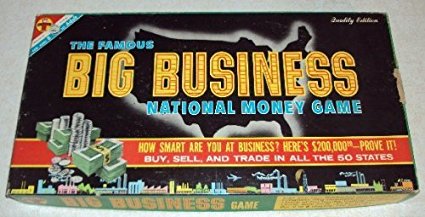Dug out from my Feedly 'Read later' list was the announcement a couple of weeks ago of the latest iteration of the venerable Fortune 500 - the annual list of the largest 500 US companies (ranked by annual revenues).
The Fortune 500 has become a synonym for 'big business' in America, and taking a look through the list, and especially looking at changes and trends in the list, has become an annual exercise for folks like me who like to think about macro trends in the economy, and to think about how these trends suggest what might be coming next.
Also, it's just fun. If you are a geek like me.
So for an almost-summer Friday, here's my first five quick observations from looking the new Fortune 500"
1. For all the talk about technology that dominates most business news cycles and programs, old-fashioned retailer Walmart remains number one on the list - and it isn't really even close. Walmart has double the revenues of the next closest rival for the top spot, ExxonMobil. And while we know all about the massive businesses in retail and in cloud computing, (an odd combination), that Amazon has built over the years, Walmart still has almost 3x the revenue as their competitor from the Northwest. I know I like to think of Amazon as the most interesting and important company in America, but we can't or shouldn't forget the outsize impact of boring old Walmart. And don't forget their 2.3 million (with an 'm', employees).
2. Lots of 'The future is changing, are you ready' presentations like to talk about how much turnover there is over time in the list of Fortune 500 members. While interesting, I find it even more interesting, given the massive changes in business, technology, society, and more since the list's inception in 1955, that 53 companies (ExxonMobil, GE, Chevron, and GM to name some), have been on the list every year since 1955. That over 10% of the largest companies in American have been there for over 60 years is remarkable to me.
3. Despite point 1 about Walmart's staggering size, it is true that technology or tech-dominated firms make up large portions of the upper end of the Fortune 500. Household tech names like Microsoft, Apple, Amazon, Alphabet, IBM, Intel, Facebook, Oracle, and Intel all crack the top 100. And further down the list we see Netflix, Qualcom, Nvidia, and Adobe - all companies doing incredible things in their respective markets. And while the Fortune 500 ranks by revenue, if you think about company value as expressed by market cap, (subject to stock prices fluctuations), the most valuable list is also dominated by tech - Apple, Facebook, Amazon, Microsoft, and Alphabet are five of the top six most valuable companies in America.
4. There are 30 'mega-employers' on the list - companies with over 200,000 employees as of the date the list was compiled. The above mentioned Walmart leads the employment table, but some other notable massive employers are Amazon, (566,000); Home Depot, (413,000); Starbucks, (277,000); UnitedHealth Group (260,000); JP MorganChase, (252,000); and Ford Motor (202,000). And coming in just below the 200k employee threshhold are big names like Disney, Marriott, Boeing, Oracle, Microsoft, and Apple - each having more than 100K employees.
5. There are only 17 new companies on the list this year. The most interesting 'newcomers' to the Fortune 500 are, for me, Molson Coors Brewing, (Coors was my preferred beer once upon a time), Wynn Resorts, (I still need to get to Macau), and Conduent, (I just talked with them this week, look for an HR Happy Hour Show coming soon featuring some folks from Conduent). The last new entrant on the list is corporate supply company Cintas checking in at 500. For perspective, the last company on the list is a giant organization of 42,000 employees and 900,000 customers.
Ok, that's it from my quick walk down the Fortune 500 this year, I find it interesting every year, hope you do too.
Have a great weekend!

 Steve
Steve


